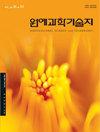核桃(Juglans regia L.)碳水化合物同化和分布特征
IF 0.8
4区 农林科学
Q3 HORTICULTURE
Korean Journal of Horticultural Science & Technology
Pub Date : 2021-04-01
DOI:10.7235/HORT.20210014
引用次数: 2
摘要
利用~(13)C同位素示踪技术,研究了核桃果实生长发育不同阶段环带结实梢不同器官和不同代谢组分的~(13 C)C丰度(δ13 C)、~(13 Camount)C含量和新的固定~(13 CPCT)C百分比。我们的目的是分析核桃果实生长发育不同阶段碳水化合物同化、运输和利用的动态特征。结果表明:(1)饲喂后0 h,叶片蔗糖中δ13C、13Camount和13CPCT含量最高,与叶片净光合速率呈正相关(p<0.05);(2) 在饲喂后24小时,来自车棚的蔗糖中的δ13C、13Camount和13CPCT达到峰值;(3) 在速生期饲喂后48 h,果皮蔗糖中的δ13C、13Camount和13CPCT均低于己糖,但在油转化期饲喂后48h,果皮蔗糖均达到最大水平;(4)饲喂48 h后,籽粒中所有碳水化合物的δ13C、13Camount和13CPCT最高,其中蔗糖中的δ13c、13CamMount和13CPT最高。这些结果表明,蔗糖是核桃果实中碳水化合物同化和运输的主要形式,大量的蔗糖积累在果皮和仁中,也是油脂转化的基础。附加关键词:13C同位素、拼果、果实发育、光合作用、季节变化本文章由计算机程序翻译,如有差异,请以英文原文为准。
Characteristics of Carbohydrate Assimilation and Distribution in Walnut (Juglans regia L.)
Based on 13 C isotope tracer technology, we investigated the 13 C abundance (δ 13 C), 13 C content ( 13 Camount), and new fixed 13 C percentage ( 13 CPCT) in different organs and different metabolic components in girdled fruit-bearing shoots at different stages of fruit growth and development in walnut. Our aim was to analyze the dynamic characteristics of carbohydrate assimilation, transportation, and utilization in different stages of walnut fruit growth and development. The results showed that (1) at 0 h after the feeding, δ 13 C, 13 Camount, and 13 CPCT in sucrose from the leaves were the highest and positively correlated with net photosynthetic rate of leaves (p < 0.05); (2) at 24 h after the feeding, δ 13 C, 13 Camount, and 13 CPCT in sucrose from the carpopodium reached their peak values; (3) δ 13 C, 13 Camount, and 13 CPCT in sucrose from the peel were lower than those of hexose at 48 h after feeding in the fast-growing stage, but they all reached maximum levels in peel sucrose at 48 h after feeding in the oil conversion stage; and (4) the highest δ 13 C, 13 Camount, and 13 CPCT were recorded in all carbohydrates from the seed kernel 48 h after feeding, among which the highest δ 13 C, 13 Camount, and 13 CPCT were recorded in sucrose. These results suggested that sucrose was the main form of carbohydrate assimilation and transportation in walnut fruit, and large amounts of sucrose are accumulated in the peel and in the kernel, where it is also the base for the transformation of oil. Additional key words: 13 C isotope, carpopodium, fruit development, photosynthesis, seasonal changes
求助全文
通过发布文献求助,成功后即可免费获取论文全文。
去求助
来源期刊
CiteScore
2.00
自引率
0.00%
发文量
0
审稿时长
1 months
期刊介绍:
Horticultural Science and Technology (abbr. Hortic. Sci. Technol., herein ‘HST’; ISSN, 1226-8763), one of the two official journals of the Korean Society for Horticultural Science (KSHS), was launched in 1998 to provides scientific and professional publication on technology and sciences of horticultural area. As an international journal, HST is published in English and Korean, bimonthly on the last day of even number months, and indexed in ‘SCIE’, ‘SCOPUS’ and ‘CABI’. The HST is devoted for the publication of technical and academic papers and review articles on such arears as cultivation physiology, protected horticulture, postharvest technology, genetics and breeding, tissue culture and biotechnology, and other related to vegetables, fruit, ornamental, and herbal plants.

 求助内容:
求助内容: 应助结果提醒方式:
应助结果提醒方式:


